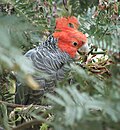Difference between revisions of "AY Honors/Parrots and Cockatoos/Answer Key"
From Pathfinder Wiki
< AY Honors | Parrots and CockatoosAY Honors/Parrots and Cockatoos/Answer Key
| Line 1: | Line 1: | ||
{{Taxobox | color = pink | {{Taxobox | color = pink | ||
| − | | name = | + | | name = Gang-gang Cockatoo |
| status = {{StatusLeastConcern}} | | status = {{StatusLeastConcern}} | ||
| − | | image = | + | | image = Gang-gang female MJC01.jpg |
| caption = | | caption = | ||
| regnum = [[Animal]]ia | | regnum = [[Animal]]ia | ||
| Line 9: | Line 9: | ||
| ordo = [[Psittaciformes]] | | ordo = [[Psittaciformes]] | ||
| familia = [[Cacatuidae]] | | familia = [[Cacatuidae]] | ||
| − | + | | genus = ''''' Callocephalon''''' | |
| − | | genus = ''''' | + | | species = '''''C. fimbriatum ''''' |
| − | | species = ''''' | + | | binomial = Callocephalon fimbriatum |
| − | | binomial = | + | | binomial_authority = [[John B. Grant|Grant]], [[1803]] / [[Rene Primevere Lesson|Lesson]], [[1837]] |
| − | | binomial_authority = [[ | + | | range_map = Bird range gang-gang cockatoo.png |
| − | | range_map = Bird range | ||
| range_map_width = 150px | | range_map_width = 150px | ||
| − | | range_map_caption = | + | | range_map_caption = Gang-gang Cockatoo range (in red) |
}} | }} | ||
| − | The ''' | + | The '''Gang-gang Cockatoo''', ''Callocephalon fimbriatum '', is member of the [[cockatoo]] family. It is a shy, mostly-grey parrot of [[Australia]]n alpine [[bushland]]. The male has a red head and [[Crest (bird)|crest]] while the female has a small fluffy grey crest. It ranges through out South Eastern Australia and [[Tasmania]]. The Gang-gang cockatoo is the faunal emblem of the [[Australian Capital Territory]]. |
| − | + | Gang-gang Cockatoos require hollow tree trunks or branches to place their nesting sites. A loss of this habitat across south-eastern Australia through land clearing has led to a significant reduction in the numbers of this Cockatoo in recent years. | |
| − | + | ==External link== | |
| − | + | *[http://www.araproject.nl Araproject: Where parrots are wild in flying colour! Naturalized parrots in the Netherlands] | |
| − | + | * [http://www.nationalparks.nsw.gov.au/npws.nsf/Content/Gang-gang_cockatoo_vulnerable_preliminary NSW National Parks & Wildlife - Proposed vulnerable species listing] | |
| + | *[http://www.birdlife.org/datazone/species/index.html?action=SpcHTMDetails.asp&sid=1395&m=0 BirdLife Species Factsheet] | ||
==References== | ==References== | ||
| Line 31: | Line 31: | ||
* Flegg, Jim. ''Birds of Australia: Photographic Field Guide'' Sydney: Reed New Holland, [[2002]]. (ISBN 1876334789) | * Flegg, Jim. ''Birds of Australia: Photographic Field Guide'' Sydney: Reed New Holland, [[2002]]. (ISBN 1876334789) | ||
| − | == | + | ==Gallery== |
| − | |||
| − | |||
| − | + | <gallery> | |
| + | Image:Female_Gang_Gang_Cockatoo.jpg|A female Gang-gang cockatoo eating peppercorns | ||
| + | Image:Gang-gang male MJC01.jpg|Male Gang-gang cockatoo | ||
| + | Image:Gang-gang female MJC02.jpg|Female Gang-gang cockatoo | ||
| + | </gallery> | ||
[[Category:Cacatuidae]] | [[Category:Cacatuidae]] | ||
[[Category:Birds of Australia]] | [[Category:Birds of Australia]] | ||
| − | |||
| − | |||
| − | |||
Revision as of 08:03, 19 February 2006
The Gang-gang Cockatoo, Callocephalon fimbriatum , is member of the cockatoo family. It is a shy, mostly-grey parrot of Australian alpine bushland. The male has a red head and crest while the female has a small fluffy grey crest. It ranges through out South Eastern Australia and Tasmania. The Gang-gang cockatoo is the faunal emblem of the Australian Capital Territory.
Gang-gang Cockatoos require hollow tree trunks or branches to place their nesting sites. A loss of this habitat across south-eastern Australia through land clearing has led to a significant reduction in the numbers of this Cockatoo in recent years.
External link
- Araproject: Where parrots are wild in flying colour! Naturalized parrots in the Netherlands
- NSW National Parks & Wildlife - Proposed vulnerable species listing
- BirdLife Species Factsheet
References
- Flegg, Jim. Birds of Australia: Photographic Field Guide Sydney: Reed New Holland, 2002. (ISBN 1876334789)



